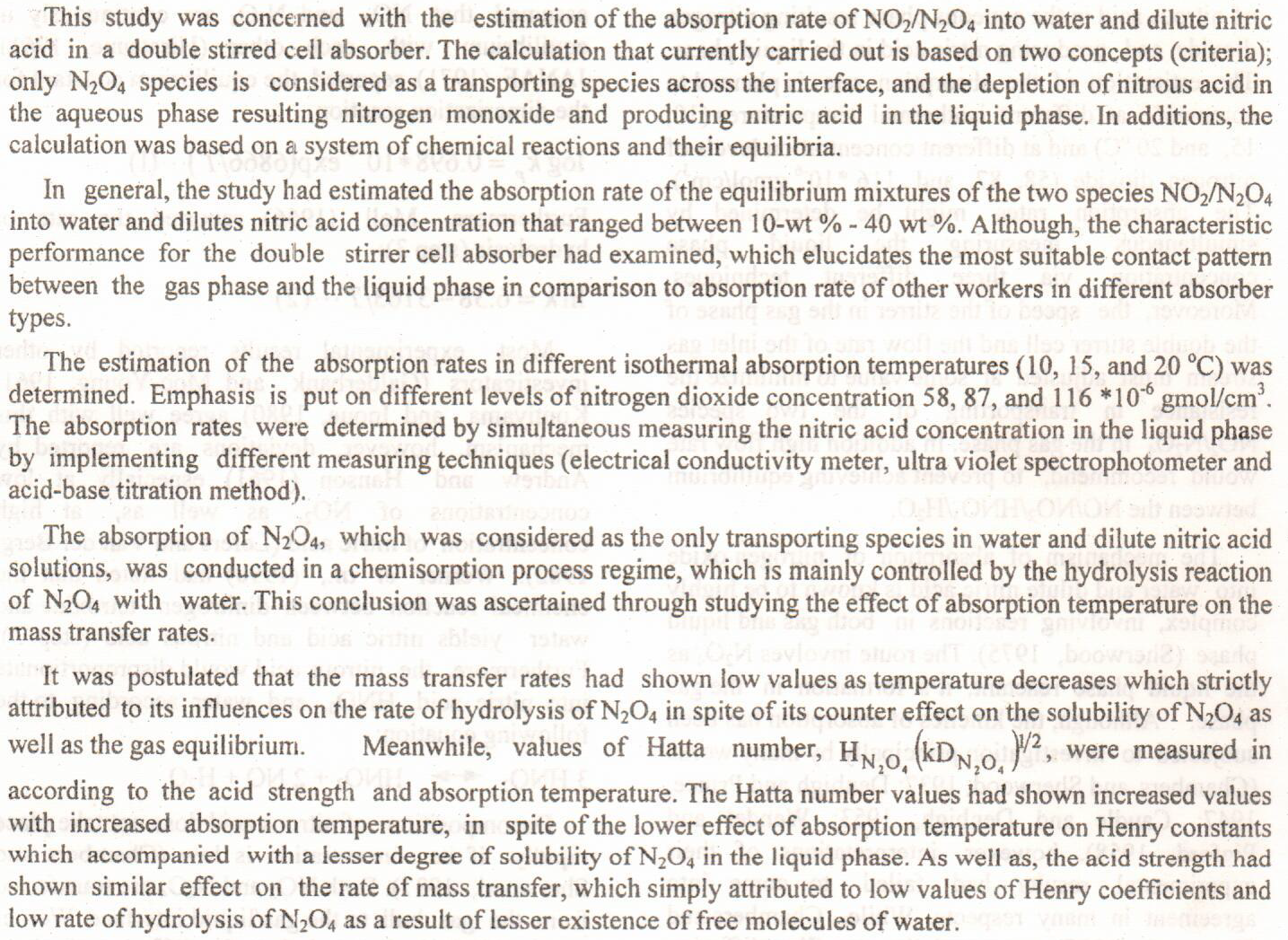
 (10)
(10)
Adsorption capacity of a waste biomass, date stones, for phenolic compounds such as phenol (Ph) and p-nitro phenol (PNPh) was investigated. The characteristics of such waste biomass were determined and found to have a surface area and iodine number of 495.71 m²/g and 475.88 mg/g, respectively. The effects of temperature, initial sorbate concentration, and contact time on the adsorption process were studied. Experimental equilibrium data for adsorption of Ph and PNPh on date stones were analyzed by the Langmuir, Freundlich and Sips isotherm models. The results show that the best fit was achieved with the Sips isotherm equation with maximum adsorption capacities of 147.09 and 179.62 mg/g for Ph and PNPh, respectively. The kinetic data wer
... Show More (2)
(2)
The cost-effective removal of heavy metal ions represents a significant challenge in environmental science. In this study, we developed a straightforward and efficient reusable adsorbent by amalgamating chitosan and vermiculite (forming the CSVT composite), and comprehensively investigated its selective adsorption mechanism. Different techniques, such as Fourier-transform infrared spectroscopy (FTIR), zeta potential analysis, scanning electron microscopy (SEM), X-ray diffraction (XRD), and Brunauer, Emmett, Teller (BET) analysis were employed for this purpose. The prepared CSVT composite exhibited a larger surface area and higher mesoporosity increasing from 1.9 to 17.24 m2/g compared to pristine chitosan. The adsorption capabilities of the
... Show More (30)
(30)
 (31)
(31)
Realistic implementation of nanofluids in subsurface projects including carbon geosequestration and enhanced oil recovery requires full understanding of nanoparticles (NPs) adsorption behaviour in the porous media. The physicochemical interactions between NPs and between the NP and the porous media grain surface control the adsorption behavior of NPs. This study investigates the reversible and irreversible adsorption of silica NPs onto oil-wet and water-wet carbonate surfaces at reservoir conditions. Each carbonate sample was treated with different concentrations of silica nanofluid to investigate NP adsorption in terms of nanoparticles initial size and hydrophobicity at different temperatures, and pressures. Aggregation behaviour and the
... Show More (51)
(51)
 (45)
(45)
This study concerns the removal of a trihydrate antibiotic (Amoxicillin) from synthetically contaminated water by adsorption on modified bentonite. The bentonite was modified using hexadecyl trimethyl ammonium bromide (HTAB), which turned it from a hydrophilic to a hydrophobic material. The effects of different parameters were studied in batch experiments. These parameters were contact time, solution pH, agitation speed, initial concentration (C0) of the contaminant, and adsorbent dosage. Maximum removal of amoxicillin (93 %) was achieved at contact time = 240 min, pH = 10, agitation speed = 200 rpm, initial concentration = 30 ppm, and adsorbent dosage = 3 g bentonite per 1L of pollutant solution. The characterization of the adsorbent, modi
... Show More (19)
(19)
 (21)
(21)
single and binary competitive sorption of phenol and p-nitrophenol onto clay modified with
quaternary ammonium (Hexadecyltrimethyl ammonium ) was investigated to obtain the
adsorption isotherms constants for each solutes. The modified clay was prepared from
blending of local bentonite with quaternary ammonium . The organoclay was characterized
by cation exchange capacity. and surface area. The results show that paranitrophenol is
being adsorbed faster than phenol . The experimental data for each solute was fitted well with
the Freundlich isotherm model for single solute and with the combination of Freundlich-
Langmuier model for binary system .
 (2)
(2)
The green synthesis of nickel oxide nanoparticles (NiO-NP) was investigated using Ni(NO3)2 as a precursor, olive tree leaves as a reducing agent, and D-sorbitol as a capping agent. The structural, optical, and morphology of the synthesized NiO-NP have been characterized using ultraviolet–visible spectroscopy (UV-Vis), X-ray crystallography (XRD) pattern, Fourier transform infrared spectroscopy (FT-IR) and scanning electron microscope (SEM) analysis. The SEM analysis showed that the nanoparticles have a spherical shape and highly crystalline as well as highly agglomerated and appear as cluster of nanoparticles with a size range of (30 to 65 nm). The Scherrer relation has been used to estimate the crystallite size of NiO-NP which ha
... Show More (24)
(24)
 (19)
(19)
In spite of increasing clinical cases which caused by enteroviruses transferred by water and no documents about entericviruses in the Iraqi water standards. The use of coliphages as an indicator of enteroviruses and fecal pollution were suggested two procedures were applied . The first is Two-Step Enrichment Method and the second is Single Agar Layer Method. Both methods gives good results in Identification of coliphages through testing fifty different water samples (Tap water, Surface water and Bottled water) the study shows the presence of coliphages in fourteen samples.
This article discusses some linguistic problems that arise when translating the Holy Quran from Arabic to Russian. We analyze lexical, syntactic and semantic problems and support them with Examples of verses from the Qur'an, since the Qur'an is the word of Allah. It contains prayers and instructions full of both literal representations and figurative comparisons. The identification of linguistic and rhetorical features challenges translators of the Holy Qur'an, especially when translating such literary devices as metaphor, assonance, epithet, irony, repetition, polysemy, metonymy, comparisons, synonymy and homonymy. The article analyzes: metaphor, metonymy, ellipsis, polysemy.
A charge transfer complex formed by interaction between nitron as electron donor with curcumin(1 ) as electron acceptor in ethanol at the temperature of theroom to form a colored complex. The optimum conditions of complex formation were investigated by Univariate method. The linearity range of complex was (3.124– 53.11) μg.mL-1 at 442 nm with molar absorptivity (1858.33) L.mol-1.cm-1, Sandell's sensitivity (0.1681μg.cm-2), and with a correlation coefficient (0.9935). Both modified attapulgite and modified attapulgite – complex have been characterized by using , FTIR, SEM, AFM, and XRD. Theadsorption behaviourof complex onto the modified attapulgite has been researchedthrough the variation of the parameters like the adsorbent weight, p
... Show More